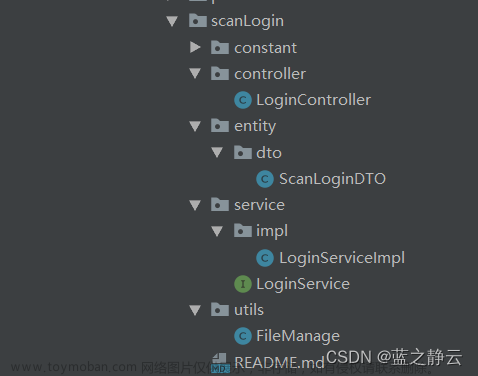一:前期准备
要想实现微信登陆,首先必须注册开发者账号。
- 登录微信开放平台,添加移动应用并提交审核,审核通过后可获取应用ID(AppID),AppSecret等信息
- 在应用详情中
申请开通微信登录功能,根据页面提示填写资料,提交审核 - 申请审核通过后即可打包使用微信授权登录功能
二:实现思路
1.app端请求调用微信登陆,用户登陆授权之后会返回一个code,通过这个code加上appid和 appSecret和可以得到access_token和openid等信息,通过access_token和openid 我们就可以去查询到用户基本登陆信息了。

三:具体实现
1.配置
在Hbulidx工具里打开uniapp项目,找到
manifest.json文件,在“App模块配置”项的“OAuth(登录鉴权)”下,勾选“微信登录”:

- appid
微信开放平台申请应用的AppID值 - appSecret(HBuilderX3.4.18+ 不再提供此参数的可视化配置,详见配置参数安全性问题)
微信开放平台申请应用的AppSecret值 - UniversalLinks
iOS平台通用链接,必须与微信开放平台配置的一致,推荐使用一键生成iOS通用链接
2.前端代码
<template>
<view class="content">
<view class="text-area">
<button @click="wxlogin">微信登陆</button>
</view>
</view>
</template>
<script>
export default {
data() {
return {
title: 'Hello'
}
},
onLoad() {
},
methods: {
wxlogin() {
uni.login({
provider: 'weixin', //使用微信登录
// onlyAuthorize: true,
success: function (loginRes) {
console.log(loginRes.authResult);
console.log("loginRes.authResult.accessToken="+loginRes.authResult.access_token)
uni.request({
url: 'http://192.168.1.9:8085/wx/login', //仅为示例,并非真实接口地址。
method:'GET',
data: {
accessToken:loginRes.authResult.access_token,
openid:loginRes.authResult.openid,
},
});
},
})
}
},
}
</script>
<style>
</style>
这里就简单展示一下,效果图:

点击登陆后就会自动跳转到微信登陆授权页面了。
3.后端代码
1.WechatTokenEntity类
package com.jdzh.enterprise.wxlogin;
/**
* 描述: 凭证 </br>
* 发布版本:V1.0 </br>
*/
public class WechatTokenEntity {
/**
* 接口访问凭证֤
*/
private String accessToken;
/**
* 接口访问凭证֤,刷新
*/
private String refreshToken;
/**
* 凭证有效期单位:second
*/
private int expiresIn;
/**
* 授权用户唯一标识
*/
private String openid;
/**
* 微信用户唯一标识
*/
private String unionId;
public String getOpenid() {
return openid;
}
public void setOpenid(String openid) {
this.openid = openid;
}
public String getAccessToken() {
return accessToken;
}
public void setAccessToken(String accessToken) {
this.accessToken = accessToken;
}
public int getExpiresIn() {
return expiresIn;
}
public void setExpiresIn(int expiresIn) {
this.expiresIn = expiresIn;
}
public String getUnionId() {
return unionId;
}
public void setUnionId(String unionId) {
this.unionId = unionId;
}
public String getRefreshToken() {
return refreshToken;
}
public void setRefreshToken(String refreshToken) {
this.refreshToken = refreshToken;
}
}
2.WechatTrustManager类
package com.jdzh.enterprise.wxlogin;
import java.security.cert.CertificateException;
import java.security.cert.X509Certificate;
import javax.net.ssl.X509TrustManager;
/**
* 描述:信任管理器 </br>
* 发布版本:V1.0 </br>
*/
/*
* 证书管理器的作用是让它新人我们指定的证书,
* 此类中的代码意味着信任所有的证书,不管是不是权威机构颁发的。
*/
public class WechatTrustManager implements X509TrustManager {
// 检查客户端证书
public void checkClientTrusted(X509Certificate[] chain, String authType) throws CertificateException {
}
// 检查服务器端证书
public void checkServerTrusted(X509Certificate[] chain, String authType) throws CertificateException {
}
// 返回受信任的X509证书数组
public X509Certificate[] getAcceptedIssuers() {
return null;
}
}
3.WechatUserEntity
package com.jdzh.enterprise.wxlogin;
import java.io.Serializable;
/**
* 用户管理InfoVO
*
* @author es
* @email es@126.com
*/
public class WechatUserEntity implements Serializable {
private static final long serialVersionUID = 1L;
/**
* 用户的标识
*/
private String openId;
/**
* 关注状态(1是关注,0是未关注),未关注时获取不到其余信息
*/
private int subscribe;
/**
* 用户关注时间,为时间戳。如果用户曾多次关注,则取最后关注时间
*/
private String subscribeTime;
/**
* 昵称
*/
private String nickname;
/**
* 用户的性别(1是男性,2是女性,0是未知)
*/
private int sex;
/**
* 用户所在国家
*/
private String country;
/**
* 用户所在省份
*/
private String province;
/**
* 用户所在城市
*/
private String city;
/**
* 用户的语言,简体中文为zh_CN
*/
private String language;
/**
* 用户头像
*/
private String headImgUrl;
/**
* 用户特权信息
*/
private String PrivilegeList;
/**
* 微信授权用户唯一标识
*/
private String unionId;
public String getOpenId() {
return openId;
}
public void setOpenId(String openId) {
this.openId = openId;
}
public int getSubscribe() {
return subscribe;
}
public void setSubscribe(int subscribe) {
this.subscribe = subscribe;
}
public String getSubscribeTime() {
return subscribeTime;
}
public void setSubscribeTime(String subscribeTime) {
this.subscribeTime = subscribeTime;
}
public String getNickname() {
return nickname;
}
public void setNickname(String nickname) {
this.nickname = nickname;
}
public int getSex() {
return sex;
}
public void setSex(int sex) {
this.sex = sex;
}
public String getCountry() {
return country;
}
public void setCountry(String country) {
this.country = country;
}
public String getProvince() {
return province;
}
public void setProvince(String province) {
this.province = province;
}
public String getCity() {
return city;
}
public void setCity(String city) {
this.city = city;
}
public String getLanguage() {
return language;
}
public void setLanguage(String language) {
this.language = language;
}
public String getHeadImgUrl() {
return headImgUrl;
}
public void setHeadImgUrl(String headImgUrl) {
this.headImgUrl = headImgUrl;
}
public String getPrivilegeList() {
return PrivilegeList;
}
public void setPrivilegeList(String privilegeList) {
PrivilegeList = privilegeList;
}
public String getUnionId() {
return unionId;
}
public void setUnionId(String unionId) {
this.unionId = unionId;
}
}
4.WechatUtils
package com.jdzh.enterprise.wxlogin;
import net.sf.json.JSONException;
import net.sf.json.JSONObject;
import org.slf4j.Logger;
import org.slf4j.LoggerFactory;
import javax.net.ssl.HttpsURLConnection;
import javax.net.ssl.SSLContext;
import javax.net.ssl.SSLSocketFactory;
import javax.net.ssl.TrustManager;
import java.io.BufferedReader;
import java.io.InputStream;
import java.io.InputStreamReader;
import java.io.OutputStream;
import java.net.ConnectException;
import java.net.URL;
import java.nio.charset.StandardCharsets;
public class WechatUtils {
private final static Logger log = LoggerFactory.getLogger(WechatUtils.class);
private final static String appid = "appid"; //凭证
private final static String appsecret = "appsecret"; //凭证密钥
// 凭证获取(GET)
public final static String tokenUrl = "https://api.weixin.qq.com/sns/oauth2/access_token?appid=APPID&secret=SECRET&code=CODE&grant_type=authorization_code";
//userinfo
public final static String userInfoUrl = "https://api.weixin.qq.com/sns/userinfo?access_token=ACCESS_TOKEN&openid=OPENID&lang=zh_CN";
/**
* 获取接口访问凭证
*
* @param code app授权后传回
* @return
*/
public static WechatTokenEntity getToken(String code) {
WechatTokenEntity token = new WechatTokenEntity();
// long now = new Date().getTime();
// if (tokenTime != 0 && now - tokenTime < 7000000) {//token有效时间 7e6 毫秒
// return token;
// }
String requestUrl = tokenUrl.replace("APPID", appid).replace("SECRET", appsecret).replace("CODE", code);
// 发起GET请求获取凭证
JSONObject jsonObject = httpsRequest(requestUrl, "GET", null);
if (null != jsonObject) {
try {
token.setUnionId(jsonObject.getString("unionid"));
token.setOpenid(jsonObject.getString("openid"));
token.setAccessToken(jsonObject.getString("access_token"));
token.setRefreshToken(jsonObject.getString("refresh_token"));
token.setExpiresIn(jsonObject.getInt("expires_in"));
} catch (JSONException e) {
token = null;
// 获取token失败
log.error("获取token失败 errcode:{} errmsg:{}", jsonObject.getInt("errcode"), jsonObject.getString("errmsg"));
}
}
return token;
}
public static void main(String args[]) {
// 获取接口访问凭证
// 我这里是直接从前端传入accessToken,openid,所以可以直接拿到,下面是通过code生成
String accessToken = getToken("code").getAccessToken();
String openid = getToken("code").getOpenid();
// /**
// * 获取用户信息
// */
WechatUserEntity user = getUserInfo(accessToken, openid);
//做这个测试的时候可以先关注,或者取消关注,控制台会打印出来此用户的openid
System.out.println("OpenID:" + user.getOpenId());
System.out.println("关注状态:" + user.getSubscribe());
System.out.println("关注时间:" + user.getSubscribeTime());
System.out.println("昵称:" + user.getNickname());
System.out.println("性别:" + user.getSex());
System.out.println("国家:" + user.getCountry());
System.out.println("省份:" + user.getProvince());
System.out.println("城市:" + user.getCity());
System.out.println("语言:" + user.getLanguage());
System.out.println("头像:" + user.getHeadImgUrl());
getToken("02315v0w35TA603fsF0w3Q0fov415v0B");
}
/**
* 获取用户信息
*
* @param accessToken 接口访问凭证
* @param openId 用户标识
* @return WeixinUserInfo
*/
public static WechatUserEntity getUserInfo(String accessToken, String openId) {
WechatUserEntity wechatUserEntity = null;
// 拼接请求地址
String requestUrl = userInfoUrl.replace("ACCESS_TOKEN", accessToken).replace("OPENID", openId);
// 获取用户信息
JSONObject jsonObject = httpsRequest(requestUrl, "GET", null);
if (null != jsonObject) {
try {
wechatUserEntity = new WechatUserEntity();
// 用户的标识
wechatUserEntity.setOpenId(jsonObject.getString("openid"));
wechatUserEntity.setUnionId(jsonObject.getString("unionid"));
// 关注状态(1是关注,0是未关注),未关注时获取不到其余信息
// wechatUserEntity.setSubscribe(jsonObject.getInt("subscribe"));
// 用户关注时间
// wechatUserEntity.setSubscribeTime(jsonObject.getString("subscribe_time"));
// 昵称
wechatUserEntity.setNickname(jsonObject.getString("nickname"));
// 用户的性别(1是男性,2是女性,0是未知)
// wechatUserEntity.setSex(jsonObject.getInt("sex"));
// 用户所在国家
// wechatUserEntity.setCountry(jsonObject.getString("country"));
// 用户所在省份
// wechatUserEntity.setProvince(jsonObject.getString("province"));
// 用户所在城市
// wechatUserEntity.setCity(jsonObject.getString("city"));
// 用户的语言,简体中文为zh_CN
wechatUserEntity.setLanguage(jsonObject.getString("language"));
// 用户头像
wechatUserEntity.setHeadImgUrl(jsonObject.getString("headimgurl"));
} catch (Exception e) {
int errorCode = jsonObject.getInt("errcode");
String errorMsg = jsonObject.getString("errmsg");
// System.err.printf("获取用户信息失败 errcode:{} errmsg:{}", errorCode, errorMsg);
}
}
return wechatUserEntity;
}
/**
* 发送https请求
*
* @param requestUrl 请求地址
* @param requestMethod 请求方式(GET、POST)
* @param outputStr 提交的数据
* @return JSONObject(通过JSONObject.get ( key)的方式获取json对象的属性值)
*/
public static JSONObject httpsRequest(String requestUrl, String requestMethod, String outputStr) {
JSONObject jsonObject = null;
try {
// 创建SSLContext对象,并使用我们指定的信任管理器初始化
TrustManager[] tm = {new WechatTrustManager()};
SSLContext sslContext = SSLContext.getInstance("SSL", "SunJSSE");
sslContext.init(null, tm, new java.security.SecureRandom());
// 从上述SSLContext对象中得到SSLSocketFactory对象
SSLSocketFactory ssf = sslContext.getSocketFactory();
URL url = new URL(requestUrl);
HttpsURLConnection conn = (HttpsURLConnection) url.openConnection();
conn.setSSLSocketFactory(ssf);
conn.setDoOutput(true);
conn.setDoInput(true);
conn.setUseCaches(false);
// 设置请求方式(GET/POST)
conn.setRequestMethod(requestMethod);
// 当outputStr不为null时向输出流写数据
if (null != outputStr) {
OutputStream outputStream = conn.getOutputStream();
// 注意编码格式
outputStream.write(outputStr.getBytes(StandardCharsets.UTF_8));
outputStream.close();
}
// 从输入流读取返回内容
InputStream inputStream = conn.getInputStream();
InputStreamReader inputStreamReader = new InputStreamReader(inputStream, StandardCharsets.UTF_8);
BufferedReader bufferedReader = new BufferedReader(inputStreamReader);
String str = null;
StringBuilder stringBuilder = new StringBuilder();
while ((str = bufferedReader.readLine()) != null) {
stringBuilder.append(str);
}
// 释放资源
bufferedReader.close();
inputStreamReader.close();
inputStream.close();
inputStream = null;
conn.disconnect();
jsonObject = JSONObject.fromObject(stringBuilder.toString());
} catch (ConnectException ce) {
System.err.printf("连接超时:{}", ce);
} catch (Exception e) {
System.err.printf("https请求异常:{}", e);
}
return jsonObject;
}
}
调用main方法就可以得到我们要的用户信息了。
至于controller层怎么写,大家可以参考一下我的
package com.jdzh.enterprise.wxlogin;
import com.jdzh.enterprise.framework.entity.RespBean;
import com.jdzh.enterprise.framework.entity.User;
import com.jdzh.enterprise.framework.service.IUserService;
import net.sf.json.JSONException;
import net.sf.json.JSONObject;
import org.slf4j.Logger;
import org.slf4j.LoggerFactory;
import org.springframework.beans.factory.annotation.Autowired;
import org.springframework.web.bind.annotation.GetMapping;
import org.springframework.web.bind.annotation.RequestMapping;
import org.springframework.web.bind.annotation.RestController;
import javax.net.ssl.HttpsURLConnection;
import javax.net.ssl.SSLContext;
import javax.net.ssl.SSLSocketFactory;
import javax.net.ssl.TrustManager;
import java.io.BufferedReader;
import java.io.InputStream;
import java.io.InputStreamReader;
import java.io.OutputStream;
import java.net.ConnectException;
import java.net.URL;
import java.nio.charset.StandardCharsets;
@RestController
@RequestMapping("/wx")
public class WxLoginController {
@Autowired
IUserService iUserService;
private final static Logger log = LoggerFactory.getLogger(WechatUtils.class);
private final static String appid = "appid "; //凭证
private final static String appsecret = "appsecret "; //凭证密钥
// 凭证获取(GET)
public final static String tokenUrl = "https://api.weixin.qq.com/sns/oauth2/access_token?appid=APPID&secret=SECRET&code=CODE&grant_type=authorization_code";
//userinfo
public final static String userInfoUrl = "https://api.weixin.qq.com/sns/userinfo?access_token=ACCESS_TOKEN&openid=OPENID&lang=zh_CN";
@GetMapping("/login")
public RespBean login(String accessToken, String openid) {
// System.out.println("code = " + code);
// // 获取接口访问凭证
// String accessToken = getToken(code).getAccessToken();
// String openid = getToken(code).getOpenid();
System.out.println("accessToken = " + accessToken);
System.out.println("openid = " + openid);
/**
* 获取用户信息
*/
WechatUserEntity wechatUserEntity = getUserInfo(accessToken, openid);
// System.out.println("关注状态:" + wechatUserEntity.getSubscribe());
// System.out.println("关注时间:" + wechatUserEntity.getSubscribeTime());
System.out.println("昵称:" + wechatUserEntity.getNickname());
// System.out.println("性别:" + wechatUserEntity.getSex());
// System.out.println("国家:" + wechatUserEntity.getCountry());
// System.out.println("省份:" + wechatUserEntity.getProvince());
// System.out.println("城市:" + wechatUserEntity.getCity());
// System.out.println("语言:" + wechatUserEntity.getLanguage());
System.out.println("头像:" + wechatUserEntity.getHeadImgUrl());
String nickname = wechatUserEntity.getNickname();
if(wechatUserEntity!=null){
//将用户信息存在数据库中
User user = new User();
user.setOpenid(openid);
user.setNickname(nickname);
user.setIsVip(0);
//查询openId是否存在
User user1 = iUserService.findByOpenId(openid);
if(user1==null){
//如果不存在,则添加
iUserService.save(user);
}else{
System.out.println("用户信息已存在");
}
return RespBean.ok("登陆成功",wechatUserEntity);
}else{
return RespBean.error("登陆失败",wechatUserEntity);
}
}
/**
* 获取用户信息
*
* @param accessToken 接口访问凭证
* @param openid 用户标识
* @return WeixinUserInfo
*/
public static WechatUserEntity getUserInfo(String accessToken, String openid) {
WechatUserEntity wechatUserEntity = null;
// 拼接请求地址
String requestUrl = userInfoUrl.replace("ACCESS_TOKEN", accessToken).replace("OPENID", openid);
// 获取用户信息
JSONObject jsonObject = httpsRequest(requestUrl, "GET", null);
if (null != jsonObject) {
try {
wechatUserEntity = new WechatUserEntity();
// 用户的标识
wechatUserEntity.setOpenId(jsonObject.getString("openid"));
wechatUserEntity.setUnionId(jsonObject.getString("unionid"));
// 关注状态(1是关注,0是未关注),未关注时获取不到其余信息
// wechatUserEntity.setSubscribe(jsonObject.getInt("subscribe"));
// 用户关注时间
// wechatUserEntity.setSubscribeTime(jsonObject.getString("subscribe_time"));
// 昵称
wechatUserEntity.setNickname(jsonObject.getString("nickname"));
// 用户的性别(1是男性,2是女性,0是未知)
// wechatUserEntity.setSex(jsonObject.getInt("sex"));
// 用户所在国家
// wechatUserEntity.setCountry(jsonObject.getString("country"));
// 用户所在省份
// wechatUserEntity.setProvince(jsonObject.getString("province"));
// 用户所在城市
// wechatUserEntity.setCity(jsonObject.getString("city"));
// 用户的语言,简体中文为zh_CN
// wechatUserEntity.setLanguage(jsonObject.getString("language"));
// 用户头像
wechatUserEntity.setHeadImgUrl(jsonObject.getString("headimgurl"));
} catch (Exception e) {
int errorCode = jsonObject.getInt("errcode");
String errorMsg = jsonObject.getString("errmsg");
System.err.printf("获取用户信息失败 errcode:{} errmsg:{}", errorCode, errorMsg);
}
}
return wechatUserEntity;
}
/**
* 发送https请求
*
* @param requestUrl 请求地址
* @param requestMethod 请求方式(GET、POST)
* @param outputStr 提交的数据
* @return JSONObject(通过JSONObject.get ( key)的方式获取json对象的属性值)
*/
public static JSONObject httpsRequest(String requestUrl, String requestMethod, String outputStr) {
JSONObject jsonObject = null;
try {
// 创建SSLContext对象,并使用我们指定的信任管理器初始化
TrustManager[] tm = {new WechatTrustManager()};
SSLContext sslContext = SSLContext.getInstance("SSL", "SunJSSE");
sslContext.init(null, tm, new java.security.SecureRandom());
// 从上述SSLContext对象中得到SSLSocketFactory对象
SSLSocketFactory ssf = sslContext.getSocketFactory();
URL url = new URL(requestUrl);
HttpsURLConnection conn = (HttpsURLConnection) url.openConnection();
conn.setSSLSocketFactory(ssf);
conn.setDoOutput(true);
conn.setDoInput(true);
conn.setUseCaches(false);
// 设置请求方式(GET/POST)
conn.setRequestMethod(requestMethod);
// 当outputStr不为null时向输出流写数据
if (null != outputStr) {
OutputStream outputStream = conn.getOutputStream();
// 注意编码格式
outputStream.write(outputStr.getBytes(StandardCharsets.UTF_8));
outputStream.close();
}
// 从输入流读取返回内容
InputStream inputStream = conn.getInputStream();
InputStreamReader inputStreamReader = new InputStreamReader(inputStream, StandardCharsets.UTF_8);
BufferedReader bufferedReader = new BufferedReader(inputStreamReader);
String str = null;
StringBuilder stringBuilder = new StringBuilder();
while ((str = bufferedReader.readLine()) != null) {
stringBuilder.append(str);
}
// 释放资源
bufferedReader.close();
inputStreamReader.close();
inputStream.close();
inputStream = null;
conn.disconnect();
jsonObject = JSONObject.fromObject(stringBuilder.toString());
} catch (ConnectException ce) {
System.err.printf("连接超时:{}", ce);
} catch (Exception e) {
System.err.printf("https请求异常:{}", e);
}
return jsonObject;
}
}
User类
package com.jdzh.enterprise.framework.entity;
import com.baomidou.mybatisplus.annotation.IdType;
import com.baomidou.mybatisplus.annotation.TableField;
import com.baomidou.mybatisplus.annotation.TableId;
import com.baomidou.mybatisplus.annotation.TableName;
import lombok.AllArgsConstructor;
import lombok.Data;
import lombok.NoArgsConstructor;
import org.springframework.security.core.GrantedAuthority;
import org.springframework.security.core.userdetails.UserDetails;
import java.io.Serializable;
import java.util.Collection;
@TableName("user")
@Data
@AllArgsConstructor
@NoArgsConstructor
public class User implements Serializable , UserDetails {
private static final long serialVersionUID = 1L;
@TableId(value = "id", type = IdType.AUTO)
private Integer id;
/**
* 手机号
*/
@TableField("phone")
private String username;
/**
* 密码
*/
private String password;
/**
* openid
*/
private String openid;
/**
* 微信用户名
*/
private String nickname;
/**
* 角色身份
*/
@TableField("roleType")
private Integer roleType;
/**
* 是否是vip
*/
private Integer isVip;
/**
* vip截止日期
*/
private String endTime;
public Integer getIsVip() {
return isVip;
}
public void setIsVip(Integer isVip) {
this.isVip = isVip;
}
public String getEndTime() {
return endTime;
}
public void setEndTime(String endTime) {
this.endTime = endTime;
}
@Override
public String getUsername() {
return username;
}
@Override
public boolean isAccountNonExpired() {
return true;
}
@Override
public boolean isAccountNonLocked() {
return true;
}
@Override
public boolean isCredentialsNonExpired() {
return true;
}
@Override
public boolean isEnabled() {
return true;
}
public void setUsername(String username) {
this.username = username;
}
@Override
public Collection<? extends GrantedAuthority> getAuthorities() {
return null;
}
@Override
public String getPassword() {
return password;
}
}
RespBean
package com.jdzh.enterprise.framework.entity;
public class RespBean {
private Integer status;
private String msg;
private Object data;
public static RespBean ok(String msg,Object data){
return new RespBean(200,msg,data);
}
public static RespBean ok(String msg){
return new RespBean(200,msg,null);
}
public static RespBean error(String msg,Object data){
return new RespBean(500,msg,data);
}
public static RespBean error(String msg){
return new RespBean(500,msg,null);
}
public RespBean() {
}
public RespBean(Integer status, String msg, Object data) {
this.status = status;
this.msg = msg;
this.data = data;
}
public Integer getStatus() {
return status;
}
public void setStatus(Integer status) {
this.status = status;
}
public String getMsg() {
return msg;
}
public void setMsg(String msg) {
this.msg = msg;
}
public Object getData() {
return data;
}
public void setData(Object data) {
this.data = data;
}
}
数据库设计
小伙伴们可以根据自己的需求设计数据库表哦 文章来源:https://www.toymoban.com/news/detail-502363.html
 文章来源地址https://www.toymoban.com/news/detail-502363.html
文章来源地址https://www.toymoban.com/news/detail-502363.html
到了这里,关于uni-app +java小程序端对接微信登陆的文章就介绍完了。如果您还想了解更多内容,请在右上角搜索TOY模板网以前的文章或继续浏览下面的相关文章,希望大家以后多多支持TOY模板网!











